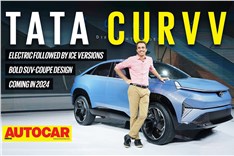Tata Curvv EV meets IAF's Suryakiran: Air Force Day Special
In what has to be our craziest idea yet, we attempt on-ground aerobatics in four Curvv EVs as a tribute to the Indian Air Force Suryakiran Aerobatic Team.
Published On Oct 08, 2024 02:06:00 PM
10,162 Views
Follow us onIn the past, we’ve done a lot of fun and crazy things, and we’ve pushed the boundaries. We’ve been fast: above 350kph. We’ve driven long: from India to Europe – twice. We’ve driven high: on the highest roads in the world. And we’ve driven heavy: a 160-tonne mining truck. Over the years, we’ve also raced fighter jets, driven trains, tanks, armoured cars, and even a hovercraft.
This time, however, we’ve probably bitten off more than we can chew. We’ve agreed to drive in formation as a tribute to a bunch of aeroplane enthusiasts – the flyboys (and girls) of the Indian Air Force. The thing is, can we do it? And can we make it look good?
 Team leader ‘Gavi’ runs us through an essential briefing;
Team leader ‘Gavi’ runs us through an essential briefing;Yeah, sure, pilots from the Suryakiran Aerobatic Team are here to help us get into formation and drive some two-dimensional manoeuvres, similar to when there are clouds that prevent a vertical display. But can we make it fly?
Bidar Air Force Station
Bidar is home to the Suryakirans. On arrival, we are greeted by two things – the rolling thunder of jets at full power ripping the air apart and weather that is not conducive to flying. Low, fast-moving clouds drift overhead, and then, as we meet some of the senior members of the team, the skies get darker and more menacing.

To be honest, I’m a bit nervous, and so are the three other drivers from Autocar India – Rahul, Jay and Cyrus. We all have different ways of showing this. Some of us get quiet and introspective, others get loud, and some are offhandish. Yeah, I know, we have to take formation-driving one step at a time and then slowly get tighter and tighter. But we all have to progress at the same rate, and that could be tough.
 Driving in close proximity is harder than you think, but we borrowed a pilot hack – using ‘markers’.
Driving in close proximity is harder than you think, but we borrowed a pilot hack – using ‘markers’.To make us look like a team, we have four Tata Curvv EVs that are all painted in steel grey. There are many Hawk trainer aircraft from other squadrons in the base, and it’s only fitting that our cars are painted in the same colour. Rakishly attractive looking – especially in this shade – the Curvv doesn’t just look good; it also has plenty of zip with 167 electric horses and a quick steering that sure will help here. The attractive looks get the attention of the pilots, who come from all corners of this massive airfield just to take a look at it. The word is out that we are on the base, and we also have loads of subscribers and personnel who come up to say hello.
The Hawk
So what’s the Tata Curvv EV up against? Something small but formidable, just like its name suggests. The BAE Hawk is produced by Hindustan Aeronautics Limited and is basically an advanced jet trainer designed to help pilots transition to faster and more difficult-to-fly jets. An important stepping stone, the Hawk plays a pivotal role in preparing our pilots for what eventually is the equivalent of climbing into a Formula 1 car in the sky. Frontline fighters are brutally fast, unforgiving and tricky at the limit, so this step up is pretty much essential.

It is powered by a single, non-afterburning Rolls-Royce Adour engine (Rolls often names its jet engines after rivers) that produces roughly 5,200 pounds of thrust and allows it to go supersonic in a dive. While it may be a trainer, it is also a combat-ready platform that can handle plus eight and minus four Gs. Remember, its predecessor, the Folland Gnat, was very effective for the IAF even when put up against supposedly more formidable rivals like the American Sabre. So don’t underestimate it.
The Suryakiran Team
Even more formidable are the pilots who fly the Hawk in the Suryakiran team. Each one is an experienced hand with thousands of hours on frontline fighters. In addition, all the pilots in this team hold the rank of Group Captain, Wing Commander or Squadron Leader, and between them, they’ve flown every single frontline fighter of the IAF – Mirage, Sukhoi, MiG, Jaguar and even HAL’s Tejas. The only 9-member aerobatic team in Asia, it also has three or four reserve pilots, some of whom are trainees. The members of the team are rotated every few years, with outgoing pilots reposted to frontline squadrons again.

What’s interesting is that once in the team, pilots fly a fixed side or even a position. This is to help with muscle memory and orientation with the rest of the team. For instance, the lefties (the pilots on the left) will instinctively drop in height before the formation banks left and stay slow to remain in formation. Each of the pilots also flies with a G suit, which inflates to prevent blood from rushing to the lower part of the body and causing blackouts or greyouts. While most group manoeuvres are done at between three and four Gs, pilots pull upwards of six Gs in tighter turns – when solo or in pairs. Remember, these guys are flying only a few feet apart, close to the ground, and at around 600kph. Try and imagine doing that at just 200kph with eight cars right next to you. Then double the speed and imagine doing a loop in perfect sync. Aha!
Getting started
Our first attempts at driving in formation, as expected, are pathetic and laughable. Thank God there’s no one but a puzzled wood dove to watch us. We must have looked a sight – all over the place, with no uniform spacing. “How’s it looking?” we ask the cameramen, struggling to get a good sequence. They politely shake their heads.

Once we get a bit of confidence, we begin to bunch up and get tighter. Driving in close proximity is an uncomfortable experience, and this is true even in a straight line. Luckily, the apron we are driving on is flat and wide, so we have plenty of space to turn. We start with really wide turns, and this is easier as the speed differential between the inside and outside Curvv EV is not high. Turning in formation is proving difficult, but the more we drive, the better we get. And our diamond formation is getting better as well.
Driving markers, we improve
In the evening, some of the pilots of the Suryakiran team come over and watch us drive. We’re soon called in and taught about ‘markers’. Basically, these are features on the aircraft ahead that pilots visually line up with. This technique helps us maintain better position as well, even in turns. Once set, all we need to do is drive the marker, or align your car with a specific part of the car ahead. This is initially daunting and difficult. And more often than not, it’s only the leader who is looking ahead and flying, or in this case, driving for the whole bunch.
 As we practise, our formation gets tighter and more uniform.
As we practise, our formation gets tighter and more uniform.
Needless to say, don’t try this at home. But as we practise, we get more comfortable with driving markers, and begin to align bits of our car better with the car ahead. Soon our formation gets tighter and more uniform. We’re clearly far from perfect and some way from good, but this technique has made us good enough, and that’s crucial. Even our crosses are getting more exciting and faster, and finally, we are looking like a team. What comes as a bit of a surprise is that the Curvv is proving to be a good companion. It has a good amount of zip, the throttle is progressive, and even regen braking is predictable and smooth.
Over to the pros

Having seen the Suryakirans before, I know what to expect. Still, seeing them charge in low – all nine shoulder-to-shoulder in a big arrow – is a sight to behold. And unlike watching an aircraft coming in for a landing, these guys aren’t hanging around. The last 300 metres or so are zipped through in a snap, and then they howl overhead at over 500kph. Woah! As if seeing this giant bat-wing formation screaming overhead isn’t enough,the team leader, Gp Capt Dhillon in Suryakiran one, pulls up and takes all nine vertical. I hear many of our cameramen scream expletives at the top of their lungs. All nine aircraft then execute a perfect loop with the ones at the sides transitioning and changing formation in the vertical.

Put yourself in the cockpit; think of the speed, the proximity of the aircraft, the extreme climb, and the G forces. And then imagine having to maintain distance and speed when you are upside down, hanging in your straps. Yeah, these are mad skills. Also, understand how smooth and perfect the ‘boss’ ‘Gavi’ Dhillon has to be. Any wobble, any adjustment of line, any unnecessary yaw is bound to cause turbulence in his wake and get people further back bobbing like corks on a rough sea. Then think of Suryakiran number four, Gp Capt ‘Sidz’ Kartik, boxed in by eight aircraft all around him. And, apart from the leader, no one else is looking straight; they are all flying markers! These guys are hardcore.
 Wing tip to wing tip at over 600kph focuses the mind.
Wing tip to wing tip at over 600kph focuses the mind.
Then follows half an hour of mind-numbing aircraft control and precision: delta turns; inverted runs at low level (hats off Wg Cdr Allen George); high-speed crosses where the closing speed is near 1,200kph; and low, surprise passes that make you jump out of your skin, with the jet thundering overhead.
25 years young

The Suryakirans turned 25 last year, and this was our little tribute to them. This also happens to be our 25th year, and of all the crazy stories we’ve done over the years, this has to be one of the most memorable. Make sure you see the Suryakirans’ exceptional display the next time they are at a show near you. Make sure you understand the speeds, the G forces, the proximity, and the physical and mental challenges involved. They are rock stars, each and every one of them, and we salute them. Fly high, Suryakirans; touch the sky with glory.
Also see:
UAZ 469 Russian military SUV driven
Arjun Main Battle Tank review, road test
SUV vs Sub: Porsche Cayenne e-hybrid and Kalvari-class submarine
Copyright (c) Autocar India. All rights reserved.










.jpg&w=234&h=156&q=90&c=1)


.jpg&w=234&h=156&q=90&c=1)





Comments
Member Login
Personal Details
No comments yet. Be the first to comment.